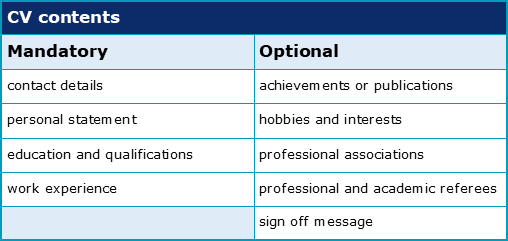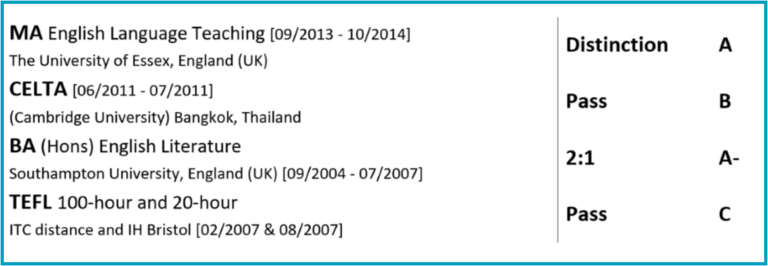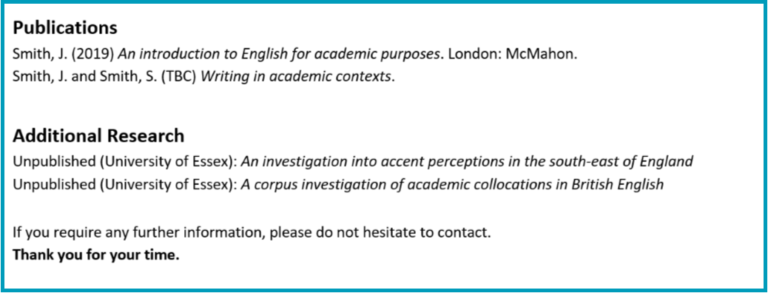What should effective CVs and resumes include?

This is the second of three chapters about Writing CVs and Resumes. To complete this reader, read each chapter carefully and then unlock and complete our materials to check your understanding.
– Discuss the optional and mandatory elements of a CV
– Explore eight CV elements in detail for the reader
– Provide excerpts of an example CV template as guidance
Chapter 2

As was explained in Chapter 1, while the difference between a CV and resume may be somewhat significant in North America, in Europe and most English-speaking countries these are regarded as being the same document. Although this second lesson on writing CVs and resumes does not offer examples of each document separately, advice is provided about effective CV and resume writing that can be applied to either document. To provide this advice effectively, the example CV that was introduced in Chapter 1 will be deconstructed, reintroduced and explored in stages.
What should CVs include?
While there are number of elements that employers expect to find in a CV, some elements are only necessary or appropriate in certain contexts. Deciding what to include may therefore depend on the type of position being applied for, the sector that position is in, and the amount of experience the applicant has. The following table is therefore designed to indicate which features are most commonly expected and which are somewhat optional.

However, writing an effective CV doesn’t simply require a knowledge of which elements must be included; applicants must also judge the level of detail expected within each element. When first entering the work place, new employees are advised to keep their CV concise enough to fit on one page (much like a resume). While this becomes increasingly difficult the more experience an individual gains, good advice to follow would be to trim down a CV until it is no more than two pages in length.
Which eight CV elements are recommended?
Element 1: Contact details
As can been seen in the example below, when including contact details the applicant’s name should stand out from the surrounding information. An up-to-date phone number (with calling code, if overseas) should be included, as should a professional email address. Whether or not a residence location and date of birth are added is somewhat country dependent, but if included they should go here.

Element 2: Personal statement
If there is no request to provide a cover letter, a short personal statement might be the most effective way of concisely and immediately catching the recruiter’s attention. Personal statements should vary depending on the job being applied for and the amount of information contained within the CV. This is an opportunity for the applicant to provide an overview of their skills, experiences and achievements, using the key language of the industry to indicate an intimate knowledge of the role being applied for. Applicants may also wish to briefly mention any relevant interests at this point in the CV, helping to paint a broader picture of the individual.
Element 3: Education and qualifications
Whether education is listed before or after an applicant’s work experience can be a personal preference or an expectation of a particular sector. For example, if entering the education sector as a professor or tutor, then the type of graduate and post-graduate certifications an applicant has is likely significant information and should therefore be listed first. An inclusion of grades here is optional and will likely depend on the level awarded and their relevance to the job. Additionally, if an applicant has a significant number of qualifications, they may wish to title the section ‘most relevant qualifications’ and remove any that are unnecessary.

Element 4: Work experience
In addition to the skills highlighted in the personal statement, it is also expected that further details of an applicant’s roles and responsibilities are provided under each listed job. This is usually most effectively done by including a list of bullet points that clearly indicate the roles that were performed, the responsibilities that were required and the skills that were developed.

Jobs are commonly listed in reverse chronology in this section, with the most recent position being included first. As can also be seen in our more thorough sample in Lesson 1, the amount of detail provided for each position becomes more concise the older the position. It is expected that if an employee is improving their career, the most recent positions will be the ones that provide the most valuable experiences.
Element 5: Referees
While it is acceptable to write ‘references provided on request’ in place of actual referees on a CV, if space permits then their inclusion may indicate to the employer that the applicant has respectable senior members of staff who can validate their experiences. The inclusion of clear referees may also be expected in some countries or cultures. In Asia, for example, the belief that an employer will only contact a referee when permission is granted by the employee is not always the case.

Please note that for those at an early stage in their career, an applicant’s referees might be academic or perhaps even personal in nature.
Element 6: Associations
Many sectors have additional societies or associations that an individual may be affiliated with or a member of. If it is relevant or beneficial, the inclusion of such memberships on a CV can indicate a genuine interest in the profession and an area of autonomous personal and professional development.

Element 7: Publications
This feature is likely not needed in many job sectors outside of academic contexts. For this reason, some CVs may instead choose to have the title ‘Achievements’ in which significant experiences may be listed instead, such as securing a substantial business contract. Nevertheless, if you do have such publications or achievements, they may be included towards the beginning or end of your CV.

Element 8: Sign off
Finally, if there is available space, it may also be a good idea to leave a sign-off message for the recruiter. This could be a stylistic preference (to prevent empty spaces on the page) or it may simply act as an opportunity to show appreciation to the potential employer by simply stating something like ‘thank you for your time’.
Now that you are familiar with the elements that should and can be included to create an effective CV, why not complete the Chapter 2 worksheet to check your progress? After completing this, continue on to Chapter 3 to learn about the most common mistakes that applicants make when applying for jobs.
To reference this reader:
Academic Marker (2022) Writing CVs and Resumes. Available at: https://academicmarker.com/careers-advice/applications/writing-cvs-and-resumes/ (Accessed: Date Month Year).
Downloadables
Once you’ve completed all three chapters in this short reader about Writing CVs and Resumes, you might then wish to download our Chapter Worksheets to check your progress or print for your students. These professional PDF worksheets can be easily accessed for only a few Academic Marks.
Chapter 1 explores the topic: What is the difference between a CV and resume? Our Chapter 1 Worksheet (containing guidance, activities and answer keys) can be accessed here at the click of a button.
Chapter 2 explores the topic: What should effective CVs and resumes include? Our Chapter 2 Worksheet (containing guidance, activities and answer keys) can be accessed here at the click of a button.
Chapter 3 explores the topic: What are seven things to avoid when writing CVs? Our Chapter 3 Worksheet (containing guidance, activities and answer keys) can be accessed here at the click of a button.
To save yourself 2 Marks, click on the button below to gain unlimited access to all of our Writing CVs and Resumes Chapter Worksheets. This All-in-1 Pack includes every chapter, activity and answer key related to this topic in one handy and professional PDF.
Collect Academic Marks
-
100 Marks for joining
-
25 Marks for daily e-learning
-
100-200 for feedback/testimonials
-
100-500 for referring your colleages/friends